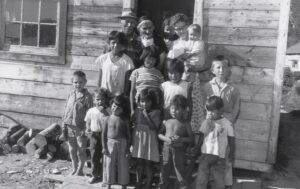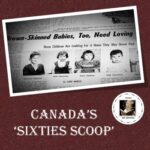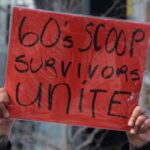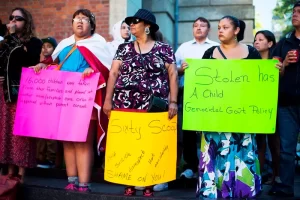
 The Sixties Scoop, often referred to simply as The Scoop, was a time when policies in Canada allowed child welfare authorities to remove Indigenous children from their families and communities to place them in foster homes. These children were then adopted by white families. Although it is called the Sixties Scoop, this practice started in the mid-to-late 1950s and continued until the 1980s. There was no given indication that these children were neglected or mistreated, just that they were Indigenous, and supposedly, therefore would be better off in the care of white families. During those years, an estimated 20,000 Indigenous children were removed from their families and placed predominantly with white middle-class families.
The Sixties Scoop, often referred to simply as The Scoop, was a time when policies in Canada allowed child welfare authorities to remove Indigenous children from their families and communities to place them in foster homes. These children were then adopted by white families. Although it is called the Sixties Scoop, this practice started in the mid-to-late 1950s and continued until the 1980s. There was no given indication that these children were neglected or mistreated, just that they were Indigenous, and supposedly, therefore would be better off in the care of white families. During those years, an estimated 20,000 Indigenous children were removed from their families and placed predominantly with white middle-class families.
The program’s policies were not uniform, with each province implementing distinct foster programs and adoption policies. Saskatchewan was unique in having the targeted Indigenous transracial adoption program known as the Adopt Indian Métis (AIM) Program. The term “Sixties Scoop” was first used in the early 1980s by social workers from the British Columbia Department of Social Welfare to describe the practice of child apprehension by their department. This term made its initial appearance in print in a 1983 report by the Canadian Council on Social Development, entitled “Native Children and the Child Welfare System.” Researcher Patrick Johnston cited the term’s origin and utilized it in his report. This term is akin to “Baby Scoop Era,” denoting the time from the late 1950s to the 1980s when many children were removed from unmarried mothers for adoption. These mothers were given no choice in the matter.
The government policies responsible for the Sixties Scoop were abandoned in the mid-1980s following resolutions passed by Ontario chiefs and severe condemnation from a Manitoba judicial inquiry. The inquiry, led by Associate Chief Judge Edwin C. Kimelman, culminated in the release of “No Quiet Place / Review Committee on Indian and Métis Adoptions and Placements,” commonly referred to as the “Kimelman Report.” Numerous lawsuits have been initiated in Canada by individuals who were part of the Sixties Scoop, including class-action suits in five provinces, such as the one initiated in British Columbia in 2011. Chief Marcia Brown Martel of the Beaverhouse First Nation was the lead plaintiff in the Ontario class-action suit filed in 2009. On February 14, 2017, Justice Edward Belobaba of the Ontario Superior Court found the government responsible for damages caused by the Sixties Scoop. Subsequently, on October 6, 2017, an $800-million settlement was disclosed for the Martel case. Currently, Métis and non-status First Nations individuals are not included in the settlement, prompting the National Indigenous Survivors of Child Welfare Network…an organization led by survivors of the Sixties Scoop in Ottawa…to call for the rejection of the settlement unless it encompasses all Indigenous individuals who were removed from their homes and placed into forced adoption.
The Sixties Scoop began during a period when Indigenous families were already grappling with the consequences of the Canadian Indian residential school system. This network of boarding schools for Indigenous peoples adversely affected their social, economic, and living conditions. The residential school system remained operational until the closure of the last school in 1996. Established by the federal government and managed by various churches, the system’s goal was to assimilate Aboriginal children by teaching them Euro-Canadian and Christian values. It enforced policies that prohibited the children from speaking their native languages, communicating with their families, or practicing their cultural traditions. Survivors of residential schools have spoken out about the physical, spiritual, sexual, and psychological abuse they endured from the staff. The enduring cultural impact on First Nations, Métis, and Inuit families and communities is both widespread and profound.
The Sixties Scoop involved the forced removal of children from their Indigenous lands and communities, often without the consent or knowledge of their families or tribes. Siblings were frequently separated and sent to different areas to prevent any communication with their relatives. These children were denied knowledge of their true nationality, history, or family ties. If a child sought to learn about their cultural identity, they required consent from their biological parents. However, due to the government’s efforts to sever ties between the children and their biological families, access to their birth records was impossible. Consequently, while the children might have suspected their cultural heritage, they had no means to verify it with concrete evidence.
The Canadian government began the process of closing the mandatory residential school system in the 1950s and 1960s, believing that Aboriginal children would receive a superior education within the public school system. A summary states: “This transition to provincial services led to a 1951 [Indian Act] amendment that enabled the province to provide services to Aboriginal people where none existed federally. Child protection was one of these areas. In 1951, twenty-nine Aboriginal children were in provincial care in British Columbia; by 1964, that number was 1,466. Aboriginal children, who had comprised only 1 percent of all children in care, came to make up just over 34 percent.”
The Truth and Reconciliation Commission (TRC) of Canada, established as part of the Indian Residential Schools Settlement Agreement, was tasked with recording the experiences of Indigenous children in residential schools. Its mission was to disseminate the truths of survivors, their families, communities, and all those impacted, to the Canadian populace. The TRC’s final report, released in 2015, details these findings: “By the end of the 1970s, the transfer of children from residential schools was nearly complete in Southern Canada, and the impact of the Sixties Scoop was in evidence across the country.” First Nations have persistently resisted such policies through various means, including legal challenges (Natural Parents v. Superintendent of Child Welfare, 1976, 60 D.L.R. 3rd 148 S.C.C) and the establishment of their own policies, like the Spallumcheen Indian Band’s by-law to manage its child welfare program, achieving varying levels of success.
In response to the loss of their children and the subsequent cultural genocide, First Nations communities took 
 action by repatriating children from failed adoptions and striving to reclaim authority over their children’s welfare practices. This movement began in 1973 with the Blackfoot (Siksika) child welfare agreement in Alberta. Currently, there are approximately 125 First Nations Child and Family Service Agencies in Canada, operating under a variety of agreements that grant them authority from provincial governments to offer services, with funding provided by the federal government.
action by repatriating children from failed adoptions and striving to reclaim authority over their children’s welfare practices. This movement began in 1973 with the Blackfoot (Siksika) child welfare agreement in Alberta. Currently, there are approximately 125 First Nations Child and Family Service Agencies in Canada, operating under a variety of agreements that grant them authority from provincial governments to offer services, with funding provided by the federal government.


Leave a Reply